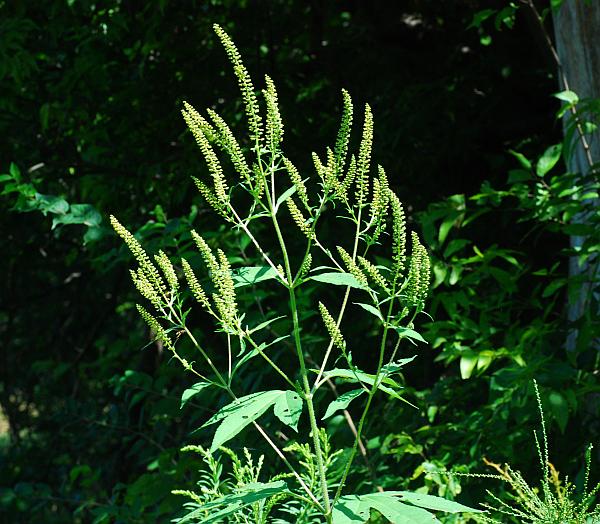Ambrosia trifida L.
Giant Ragweed

Native
CC = 0
CW = 0
MOC = 70
© SRTurner
Ambrosia trifida L.Giant Ragweed | |
 |
Native CC = 0 CW = 0 MOC = 70 |
© SRTurner |
|
Family - Asteraceae/Heliantheae Habit - Taprooted annual forb. Stems - Erect, to 5 m tall, roughened and pubescent, some hairs with pustular bases.
Leaves - Mostly opposite (the uppermost often alternate), with usually long-petiolate, the petioles of the upper leaves often narrowly winged. Leaf blades to 30 cm long, the main stem leaves to 20 cm wide, ovate to broadly elliptic or nearly circular in outline, most commonly with 3 or 5 deeply palmate lobes, the lobes oblong-elliptic to more or less elliptic or oblong-triangular, usually with numerous teeth, the upper surface sparsely to moderately roughened with short, stout, pustular-based hairs and sometimes with sparse, longer hairs along the main veins, the undersurface similarly but more sparsely roughened, not or only slightly paler than the upper surface.
Inflorescence - Staminate heads in spikelike racemes, these sometimes 3 to several in paniculate clusters, the staminate involucre 1.5-3.0 mm wide, with 5-8 shallow to moderately deep lobes, minutely hairy and usually with pronounced black lines. Pistillate heads in small axillary clusters, the involucre enclosing 1 floret and with 1 stout, conical beak, 5-10 mm long at fruiting, more or less ovoid or somewhat pear-shaped, with 4-8 longitudinal angles or ridges, each terminating in a short, stout spine, glabrous or sparsely hairy, the spines and beak often more densely hairy.
Heads - Discoid. Staminate heads with 10 or more florets, pendent. Pistillate heads with 1 or 2 florets. Pappus absent. Florets minute.
Fruits - Fruits 3.0-4.5 mm long, globose to ovoid, grayish tan to nearly black, glabrous, completely enclosed in the persistent pistillate involucre and dispersed as an intact bur.
Flowering - July - September. Habitat - Low woods, along streams, pond margins, waste ground, roadsides, railroads. Origin - Native to the U.S. Lookalikes - None close. Other info. - This species is found throughout most of Missouri, and throughout most of the U.S. It is very prolific, forming huge colonies under favorable conditions. These can be quite remarkable for the size of the plants - they truly can become giant. It favors bottomlands and agricultural fields, and is a troublesome weed of crop fields due to the emergence of glyphosate-resistant strains. When at anthesis, the plants release copious quantities of pollen, visible as yellow clouds in response to slight disturbances of the staminate inflorescences, constituting a major cause of hay fever. The species has been subdivided by some authors, though these are not formally recognized in Missouri, and also apparently can hybridize with some other members of the genus. Photographs taken at the Sunklands Conservation Area, Shannon County, MO., 8-1-04 (DETenaglia); also at Busch Wildlife Area, St. Charles County, MO, 8-30-2008, along the Meramec River in Franklin County, MO, 8-19-2011, at Route 66 State Park, St. Louis County, MO, 9-3-2019, along the Katy Trail near Marthasville, Warren County, MO, 9-15-2020; and along the Katy Trail near Treloar, Warren County, MO, 9-2-2024 (SRTurner). |